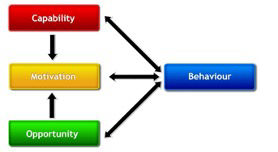Behaviour change models
Behavioural science in quantitative research Part 1

Article series
Behavioural Science in Quantitative Research
- Behaviour change models
- Behavioural economics
- Personality psychology
Over the past decade, findings from behavioural science have influenced many research agencies and their clients. Some agencies now incorporate such findings into their qualitative research offer.
However, a huge opportunity exists for clients to better understand, predict, and influence stakeholder behaviour through applying behavioural science insights and approaches to quantitative research.
This article is the first in a three-part series. The series will give the theory and tools to help rectify this. Importantly, everything described complements existing quantitative data collection methods. This means you need no significant initial investment to put any approaches described into practice.
Behavioural science in market research
“A growing body of evidence demonstrates that behavioral science insights – research findings from fields such as behavioral economics and psychology about how people make decisions and act on them – can be used to design government policies to better serve the American people…” – US President Obama, 2015
Former US leader Barack Obama supplies a succinct definition of behavioural science (BS): understanding “how people make decisions and act on them”. From this definition, BS has clear relevance to market research (MR). However, on inspection, the evidence from the academic fields Obama refers to seems only to present two big challenges.
First, human decision-making and behaviour has been shown by behavioural economists to often be complex, surprising, and even seemingly illogical. The first key challenge for MR is therefore:
1. How do we best understand human complexity, and minimize the chances of making incorrect assumptions?
Second, research participants may be unaware of many subtle influences on them. The second key challenge is therefore:
2. How do we fully unravel this complexity, if there are some things research participants can’t tell us?
Behaviour change models
Behaviour change models can help givea deep understanding of human decision-making and behaviour. Further, when employed quantitatively, they can also help unearth important influences of which participants may be unaware.
A model explains something’s operation or mechanism. The goal of behaviour change models is to help drive change. Many models begin by first helping to facilitate a deep understanding of current behavioural influencesand barriers to change. Therefore, whether the goal is behaviour change or not, models can be valuable in providing a structure to help embrace human complexity.
Models can help us develop and test informed hypotheses regarding behavioural drivers and barriers. They also provide a clear way to structure and disseminate research findings, helping audiences more easily examine and question them. Finally, if desired, they can also help to recommend, generate, and test interventions to change behaviour.
COM-B model
To show how behaviour change models help generate and test behavioural hypotheses quantitatively, we’ll usean example the University College London (UCL) developed COM-B.
UCL developed COM-B through synthesising 19 different behaviour change frameworks. In summary, the model states that to do a behaviour, someone must have three things: the Capability, Opportunity, and Motivation.

A more detailed description of each of the three key pillars is below:
Capability = the person or people concerned must have the physical strength, knowledge, skills, stamina to perform the behaviour
Opportunity = there must be a conducive physical and social environment, e.g. behaviour must be physically accessible, affordable, socially acceptable, and there must be enough time
Motivation = they must have sufficiently strong motivation, i.e. must be more motivated to do the behaviour at the relevant time than not to do it, or to engage in competing behaviour
Quantitative application – Basic
The simplest way to apply COM-B quantitatively is using an agreement scale survey question. In particular, the three pillars above are used (ideally alongside prior research) to help develop a range of hypotheses about factors which may be hindering a desired behaviour. For example, which specific Capability factors may be hindering behaviour – are they related to a lack of knowledge, or perhaps to a lack of skills? And which specific Opportunity, and Motivation factors? The perceived importance of each factor to behaviour is then tested directly with research participants.
Quantitative application – Detailed
The above approach is a useful starting point, which helps minimise the chances of incorrect assumptions, and of key omissions. However, direct questions may only take us so far.
As I stated in the second key challenge, there are often also important behavioural influences that research participants are unaware of. Fortunately, the model is particularly effective in helping tackle this challenge when applied quantitatively.
As shown by the arrows in the diagram (above), there are important inter-connecting influences in the model. For example, greater Capability can drive increased Motivation. In a recent quantitative study with physicians, we developed questions to measure current levels of Capability, Opportunity, and Motivation about the prescribing of a particular treatment. For example, under Capability, physicians’ knowledge of the efficacy and safety of the treatment was requested.
Through only a few questions, we uncovered multiple subtle relationships predicted by the model. For example, we showed that greater knowledge of efficacy and safety features of a product (Capability metrics) were significant predictors of higher levels of comfort in prescribing (Motivation metric).
Using models like COM-B quantitatively can therefore also help reveal insights of which participants aren’t necessarily aware. Further, insights like this can also help inform detailed recommendations to create change. For example, the finding above suggests Motivation can increase further through increasing Capability.
Conclusion
BS is clearly highly relevant to MR. However, it presents two significant challenges. In response, academic behaviour change models can first help by enabling a deep understanding of behaviour. Further, especially when employed quantitatively they can also help us understand key influences of which participants may be unaware.
Look out for the next article in the series. This will explain how behavioural economic approaches can be used in quantitative research to help clients better understand, predict, and influence behaviour.
This article series contains selected highlights from “Applications of Behavioural Science to Quantitative Market Research” – a new 35-page guide written by Activate Research which will be released on 27th September 2022. To pre-order a free copy, see https://www.activate-research.com/quantitative-research-guide
Chris Harvey
Founder at Activate ResearchChris Harvey is the Founder of Activate Research. He is an expert in helping research agencies add complementary insights from behavioural science (and psychology more broadly) to their research offer, enabling end clients to better understand, predict and influence target audience behaviour. Chris has over 10 years’ experience in the research industry, working for agencies including Dunnhumby, GfK and YouGov, and in 2016 achieved a Distinction in MSc Behavioural Science.
Article series
Behavioural Science in Quantitative Research
- Behaviour change models
- Behavioural economics
- Personality psychology


